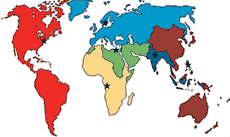


"The World Health Organization![]()
193 countries and two associate members are WHO’s membership. They meet every year at the World Health Assembly in Geneva to set policy for the Organization, approve the Organization’s budget, and every five years, to appoint the Director-General. Their work is supported by the 34-member Executive Board, which is elected by the Health Assembly. Six regional committees focus on health matters of a regional nature."
Source:
![]()
WHO's scientific publications are widely recognized as a reference source.
The WHO has a number of regional offices which address the specific issues of those regions.

| WHO African Region |
|
| WHO European Region |
|
| WHO Eastern Mediterranean Region |
|
| WHO Region of the Americas |
|
| WHO South-East Asia Region |
|
| WHO Western Pacific Region |
Deutsch: Weltgesundheitsorganisation
Español: Organización Mundial de la Salud
Français: Organisation Mondiale de la Santé
Nederlands: Wereldgezondheidsorganisatie